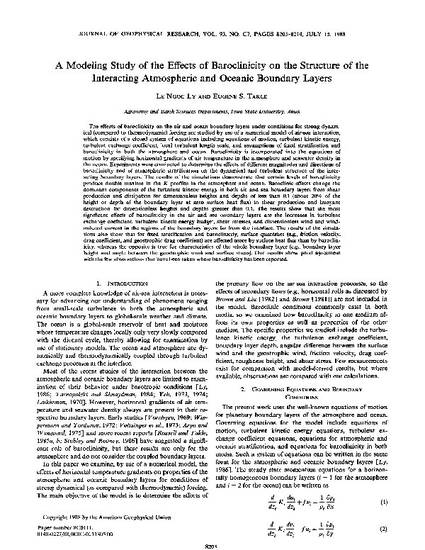
The effects of baroclinicity on the air and ocean boundary layers under conditions for strong dynamical (compared to thermodynamic) forcing are studied by use of a numerical model of air-sea interaction, which consists of a closed system of equations including equations of motion, turbulent kinetic energy, turbulent exchange coefficient, local turbulent length scale, and assumptions of fixed stratification and aroclinicity in both the atmosphere and ocean. Baroclinicity is incorporated into the equations of motion by specifying horizontal gradients of air temperature in the atmosphere and seawater density in the ocean. Experiments were conducted to determine the effects of different magnitudes and directions of baroclinicity and of atmospheric stratification on the dynamical and turbulent structure of the interacting boundary layers. The results of the simulations demonstrate that certain levels of baroclinicity produce double maxima in the K profiles in the atmosphere and ocean. Baroclinic effects change the dominant components of the turbulent kinetic energy in both air and sea boundary layers from shear production and dissipation for dimensionless heights and depths of less than 0.1 (about 20% of the height or depth of the boundary layer at zero surface heat flux) to shear production and buoyant destruction for dimensionless heights and depths greater than 0.1. The results show that the most significant effects of baroclinicity in the air and sea boundary layers are the increases in turbulent exchange coefficient, turbulent kinetic energy budget, shear stresses, and dimensionless wind and wind-induced current in the regions of the boundary layers far from the interface. The results of the simulations also show that for fixed stratification and baroclinicity, surface quantities (e.g., friction velocity, drag coefficient, and geostrophic drag coefficient) are affected more by surface heat flux than by baroclinicity, whereas the opposite is true for characteristics of the whole boundary layer (e.g., boundary layer height and angle between the geostrophic wind and surface stress). Our results show good agreement with the few observations that have been taken where baroclinicity has been reported.
Available at: http://works.bepress.com/eugene-takle/71/

This article is published as Ly, Le Ngoc, and Eugene S. Takle. "A modeling study of the effects of baroclinicity on the structure of the interacting atmospheric and oceanic boundary layers." Journal of Geophysical Research: Oceans 93, no. C7 (1988): 8203-8214. DOI:10.1029/JC093iC07p08203. Posted with permission.